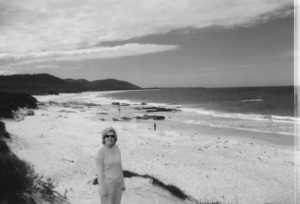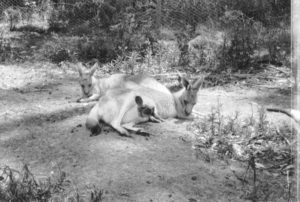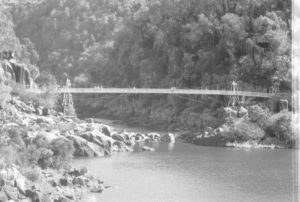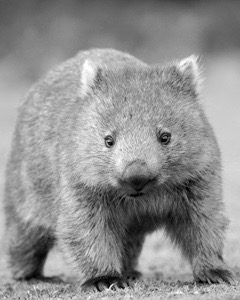A few years ago, on a cold November day I was having lunch at the St. Andrews Pub in New York’s midtown with a few of my fly-fishing buddies. Someone mentioned that he had just read and enjoyed James Prosek’s book Fly-fishing the 41st, an engaging tale of traveling and fishing around the globe following the northern 41st parallel, starting from the Author’s home in Connecticut, which inspired another to comment “You know, someone should do the same thing for the 41st parallel in the Southern Hemisphere.” The idea was so brilliant, and thus its emergence among our usually soporific group so startling, that several of us choked on our haggis. But then, the inevitable damp rag fell. “Hey, it’s just not that interesting. You’ve got New Zealand and the Lake Districts in Argentina and Chile. We’ve all been there and, anyway, people write about those places all the time. There’s nothing else.” So, another idea was shot to hell and we all went back to discussing our favorite pellet fly patterns.
But nothing else was all I had to do, so I went home and pulled out an atlas. Three months later, Ann and I were on a plane to Tasmania.
The island of Tasmania is a separate Australian state, about 150 miles south of the mainland, at a similar latitude to the northern two-thirds of New Zealand’s South Island. It’s smaller than the South Island – about the size of West Virginia – with a rugged and remote southwestern quarter latticed with deep, heavily forested gorges that render it mostly uninhabitable. The Island’s total population is only about 500,000, with roughly 70% living in and around its two principal cities – Hobart (the capital) in the south and Launceston in the north. Both cities are modern, with fine amenities and considerable colonial charm.
Tasmania has several claims to fame. It was settled (or its Aboriginal peoples might say “invaded”) in the early 19th Century almost entirely by convicts from English prisons (mostly Irish and Scottish) and others on the lam from various far-flung places. It was the birthplace of two intriguing film actors who were prominent from the 1930s through the 1950s – Errol Flynn and Merle Oberon. Flynn was a true son of Tasmania, although he left the Island for England in his teens, and ultimately spent most of his life in America, becoming a major Hollywood star, matinee idol, and legendary lothario (think “in like Flynn”). But Oberon’s story is the more interesting. The exotic-appearing actress, who was often described in terms such as “hauntingly beautiful”, was born in Hobart to affluent parents, moved to India after her father’s death, to be raised by her godparents, then at age 17 moved alone to England, where she met the eminent Hungarian film producer Alexander Korda, who hired her for a first starring film role in 1933. Two years later she married Korda, the first of her four husbands. Oberon became a renowned beauty and star in both England and America, appearing in over 50 films. She was revered in Tasmania as a heroine –living proof that Tassies could break away from their remote beginnings and accomplish great things on the world stage. In 1978, at age 67, she made a celebrated first return to Hobart and promptly announced to the press and her fans that she was born in India, and had never before set foot on the Island. The revelation crushed her Tassie followers, some of whom still refuse to believe that she was not one of them. Apparently, upon hiring her, Korda had decided that the world was not ready to idolize an Indian-born actress, especially one of mixed ethnic parentage, and had invented Tasmania as her faux birthplace because it sounded exotic and mysterious, as was she. Oberon herself perpetuated the story for nearly 50 years, even contriving many anecdotes about her early Tassie life. A year after her visit she died in Malibu.
Tasmania is the also home to some of the world’s most exotic animals, including several that are found nowhere else on earth. And finally, of importance to anglers, it is the source of New Zealand’s trout, which arrived on the Island from England in the 1860s.
Surprisingly, Tasmania’s angling reputation was greater in the first half of the 20th Century than it is today. Between about 1930 and 1960, anglers came from around the world to fish the famed “Shannon Rise” – a hatch of caddis flies on the Shannon River spanning several weeks that was among the most prolific in the world. Today, Tasmania is not a major fishing destination, probably due to a combination of a decline in the quality of fishing in some of the island’s more prominent rivers (the Shannon River is now heavily silted) and the continued development of the extraordinary New Zealand fishery. And, for most of the world’s anglers, New Zealand is a shorter trip than Tasmania.
However, I was intent on completing my southern 41st Parallel experience, so Tasmania it was. Prior to my fishing, Ann and I spent six days traveling around the Island. It’s a delightful experience. The roads are excellent (driving on the right) with light traffic, although it may be the road-kill capital of the world. Carcasses of the Island’s many nocturnal animals litter the roads, and they stay around to become maggot homes, because there are few avian scavengers and the population of Tasmanian devils, those ferocious marsupials that will eat everything including one another, has been dramatically reduced by a deadly virus. A fly-tier seeking the hair of wombat or wallaby, or even a devil, would be in heaven. The friendly wallabies can be seen everyplace – in parking lots, on the beaches, even bouncing through towns. The Tasmanian tiger-wolf, a carnivorous marsupial much bigger than the devil, became officially extinct in the 1930s, although unconfirmed sightings are occasionally reported in the Island’s wild southwest quarter.
Tasmania has 19 national parks, offering countless hiking opportunities. The views along the seacoast were particularly beautiful, reminding us of Cornwall. We saw much of the exotic wildlife, including the rare and reclusive echidna, a small spiny creature with a long slender snout, that is one of the Island’s (and the world’s) only two monotremes – egg laying mammals that suckle their young. Oh, and lest I forget, the Island’s food, beer and wine is first-rate, particularly the low-production pinot noirs which rarely venture off-island.
After our travels, I dropped Ann at the Launcestown airport for her 30+ hour trip home, and I went on to Riverfly, my fishing lodge. It is situated on a sheep farm on the North Esk River, about 45 minutes southeast of Launceston. The owner, Daniel Hackett, greeted me and informed me that I was the only guest for the next five days. Well, at least I wouldn’t have to rush to the table for first dibs on the food.
The first two days I fished several small streams – the Macquarie, the South and North branches of the Esk and Brumbys Creek – with two different guides. Although Tasmania (and, in fact, all of Australia) was in the middle of a severe drought, a very recent rain had made the streams slightly off-color. The guides were fine, but the fishing with dries and nymph droppers was slow, the few fish I caught were small, and the experience was a bit disappointing. But the food and wine at the lodge were excellent, so the days ended on a higher note.
For the last three days, Daniel was my guide. The first day we went to the St. Patricks River, a small, pretty stream hemmed in by willows. Fortunately, Daniel loaned me his 7-foot rod, and even with that a lot of roll casting was required. In most pools, Daniel spotted fish, some of which were rising (even I could see those), and I caught many 12”-15” inch browns. We arrived at one small log-jammed pool and Daniel mentioned that a large fish resided within that had been hooked four previous times this season, but never landed. Sure enough, after a few casts I hooked the allegedly elusive resident. He must have still been exhausted from his prior struggles, because he came to the net with little resistance. A pretty 20” brown.
But that big brown was not the highlight of the St. Pats. While standing under a canopy of willows, while Daniel had gone back to bring up the car, I saw at the head of a pool what looked like a trout’s back push through the water, then disappear. A minute later, I noticed a creature roughly the size and color of a muskrat swimming toward me. As it moved closer I saw the distinctive duck bill. A platypus, the other monotreme, and a mythical creature that I had only ever seen in books, swam right past my leg. I could have reached out and touched it, which as I learned later, would have been stupid given the seriously venomous spur that it carries on its hind foot. And, to compound my pleasure, a few moments later a screeching flock of large white cockatoos flew away, their slender yellow crests reflecting the bright sunlight hidden from my view. There is more to fishing than catching.
One slightly disarming aspect of wade-fishing in Tasmania, is that the guides are constantly prodding the ground ahead, trying to spook snakes that prefer living along rivers. There are only three species on the Island, but all are highly venomous and among the world’s deadliest, with the most common and dangerous being the tiger snake, which can reach a length of over six feet. The guides said that the same anti-venom works for all three species, but I was glad not to test that theory. The only snake that I saw was a large one that crossed the road in front of our car. I didn’t get out to check the species.
The next day, Daniel hitched up his rubber boat, and said that we were off to Brumbys Creek. I can’t say that I was thrilled, since my previous experience on the Creek was disappointing and it wasn’t nearly large enough to accommodate a boat. When we arrived at the launch site two things were obvious – this part of Brumbys looked more like a pond then a stream and the reeds protruding from the water were so thick that there didn’t appear to be any place to fish. But I stepped in, and Dan proceeded to push us through a hundred meters of reeds to open water. For the rest of the day we floated a few kilometers downstream in what looked like the biggest spring creek that I have ever seen. In some places, it was several hundred meters wide. Daniel explained that there are three weirs in Brumby’s, and that above each weir the water backs up to form this spring-creek like environment.
Despite having to cast from the boat (not normally my choice), it was a wonderful day of fishing. Large browns were often finning and tailing in the many narrow channels and pockets, and when they weren’t, Daniel proved to be one of the best fish-spotters that I’ve ever seen. He was also a skilled boatman, which was essential given the gusting wind and complex currents. The fish were mostly in the 15”-20” range, and were very skittish and challenging. I hooked a bunch, lost some, but had countless opportunities – which is all that I ever hope for. The most exciting targets were fish that came six inches out of the water, attempting to eat dragon and damsel flies that were hovering in the air. So, I discovered that Brumbys was, in fact, two different creeks.
The last day, Daniel again hitched up his boat and said that we were off to the Macquarie, another river that had previously disappointed me. But it was a different river way downstream – wide, deep and slightly off-color, which was slightly off-putting. Using an electric motor, we headed upstream and came to a fork, where a lovely, clear freestone river, lined with high grassy banks, came in from the left. Daniel announced that it was my old friend again – Brumbys Creek – below the third weir. Not a bit like the other two sections that I had fished.
Daniel suggested that we get out and wade-fish upstream, and I didn’t need convincing. It was mid-February (think mid-August in the U.S.) and he hoped that the fish would finally be on hoppers. They were. The rest of the day we walked up the schizophrenic Brumbys. I casted to lovely browns that occasionally rose, Daniel spotted others, and many were seduced by the hopper when I was able to place it under the cut banks. There is something in the slapdash way that a trout takes a hopper that I always eagerly anticipate, no matter how much action I’ve already had. It was a fine day – my third in a row.
For anglers, Tasmania is not New Zealand. I didn’t catch a single fish over 20”, which is a small fish in most Kiwi streams. But Tasmania has its own charms, not the least of which is the scenery and far more wildlife. And, for a more intrepid angler than I, it has hundreds of rivers that are virtually unfished, where those eight pound monsters could be lurking. Oh, and one might encounter a deadly snake, a platypus or even the devil.







